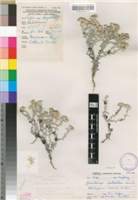Origin of name:
litorale = pertaining to the seashore
Diagnostic characters:
Small compact flower headsSmall grey bushYellow bracts
Description:
Prostrate or diffuse grey- or white-woolly herb, possibly perennial, root woody, branches several from the crown, up to 450 mm long, sometimes rooting in the lower parts, loosely branched, branchlets thinly greyish-white woolly, leafy. Leaves mostly 8-20 x (2-) 5-12 mm, considerably smaller immediately below the heads, spathulate to obovate, apex mostly rounded, tip or sometimes whole leaf folded and recurved, base narrowed, half-clasping, both surfaces greyish-white woolly, the wool sometimes closely woven. Heads homogamous or heterogamous, cylindric, c. 5 x 2-3 mm, solitary or aggregated in small glomerules c. 10 mm diam. terminating the branches and short lateral branchlets in the upper axils, surrounded by reduced leaves webbed together with wool. Involucral bracts in 4 series, outermost short, lanceolate, surrounded by 1 or 2 leaves webbed to them with wool, inner about equaling the flowers, subequal, loosely imbricate, soon caducous, tips subpellucid, or opaque at the extreme tips, mostly golden-brown, sometimes crimson, subacute to more or less truncate, then often emarginate, not radiating. Receptacle scarcely honeycombed. Flowers 9-26, 0-5 female, 9-26 homogamous. Achenes 0.75 mm long, glabrous or with myxogenic hairs. Pappus bristles in 2-3 series, very many, very delicate, equaling corolla, scabrid, bases cohering lightly by patent cilia.
Flowers mainly between November and January.
Distribution:
Common along the coast, often on the seashore dunes, from Britannia Bay north of Cape Town to Gonubie River mouth north of East London, in the SW. ranging inland as far as Tulbagh and Verkeerde Vlei, and in the E. recorded from Swartwatersberg (Albany district), and Fort Cunynghame and Dohne near Stutterheim.
Fynbos and Thicket Biomes.
Notes:
Nearly all the records are from very low altitudes; Swartwatersberg (850 m), Dohne (1 500 m), Table Mountain (760 m) appear to be exceptional.
There is no doubt that H. litorale is very close to H. tinctum and some specimens are difficult to place; but the fact that plants with more or less obtuse bracts are very nearly confined to low altitudes, plants with acuminate bracts to higher altitudes, seems sufficient reason to keep them apart. Also, although both species appear to be at the peak of their flowering in November, H. tinctum begins flowering in September and is fading in December, while early flowering records are few in H. litorale, which may flower as late as February. Very similar to H. dunense but distinguished on the abundance of pappus and prostrate growth form.
Taxonomy:
Literature:
Helichrysum litorale H. Bol. in Trans. S. Afr. phil. Soc. 18: 381 (1907); Hilliard & Burtt in Bot. J. Linn. Soc. 82: 198 (1981).
Type:
Lectotype: Cape, East London distr., sand hills on beach, Gouda River Mouth, alt. 10 ft, 24 xii 1905, Galpin 7342 (BOL; BM; PRE, isolecto.).
Synonym(s):
Gnaphalium spathulatum Thunb., Prodr. 151 (1800), Fl. Cap. 656 (1823), non Burm. f. (1768). Leontonyx spathulatus Less., Syn. Comp. 327 (1832), excl. syn. G. spadiceum Lam. (1788); Harv. in F.C. 3: 207 (1865); Levyns in Adamson & Salter, Fl. Cape Penins. 786 (1950). L. spathulatus var. hirsutus Harv., l.c. Type: Cape of Good Hope, Saldanha Bay, seashore, Thunberg (sheet 19255, UPS, holo.).
Leontonyx angustifolius DC., Prodr. 6: 168 (1838), non Helichrysum angustifolium (Lam.) Pers. Lectotype: Cape, George, Ecklon 265 (G-DC; S, isolecto.).
L. candidissimus DC., l.c. non Helichrysum candidissimum Don. L. spathulatus Less. var. candidissimus (DC.) Harv. in F.C. 3: 207 (1865). Lectotype: Cape of Good Hope, Ecklon 1017 (G-DC).
Vouchers:
Acocks 23201 (PRE); Dyer 3360 (PRE); Esterhuysen 4944 (NBG); Hilliard & Burtt 12460 (E; NU).

_sml.jpg)
_sml.jpg)
_sml.jpg)

